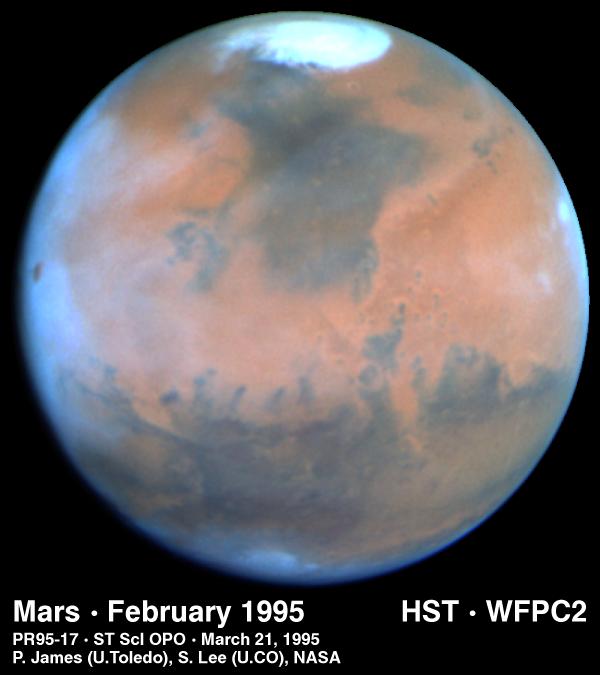
HST image of Mars: shown at reduced resolution to simulate an eyepiece view of Mars from Earth.

Percival Lowell's vision of Mars with intelligent creature built canals.
Mars imagery from the HST (left) compared to a similar view from
the NGAO 16" (right).
(NGAO image from near 2001 opposition of Mars.)



Mars imagery from HST (left) compared to similar views from the NGAO 16"
(right). Images shown at the same scale.
(All images from near 2003 opposition of Mars. The closest opposition in
60,000 years.)

The great rift valley, Vallis Marineris on Mars is evidence for
"arrested development" of plate tectonics. One global plate began
to split, but Mars cooled too rapidly for full blown plate tectonics to
develop.

Olympus Mons, the largest shield volcano in the solar system.

Surface temperature map across the polar terminator. Note that even
though some temperatures approach (even exceed) the melting point of water, the
atmospheric pressure is too low for liquid water to exist. Water melts
directly to a gas at these pressures.

Sedimentary rock layers on Mars, evidence for liquid water in the far
past.

Flood channels on Mars, more evidence for liquid water in the far past.



Evidence for more recent possible transient surface water on Mars.
(See diagram.)

A dust devil meanders across the deserts of Mars as seen from orbit.

A dust devil on Mars as seen from the Spirit rover. It is
believed the Spirit rover's solar panel were "dusted off" by a passing dust
devil.

Spirit rover panorama. (Use horizontal scroll bar to view whole image.)

Extreme close up of Martian soil. (~2x2 inches)

Evidence from the rovers has shown that Mars almost certainly had oceans and
lakes of liquid water in the past. This means Mars had a thicker
atmosphere with a greater greenhouse effect and was much wetter and warmer in
the past.
Mars' Moons Images

Demios, a captured asteroid.

Phobos, another captured asteroid.

A transit of Phobos across the face of Mars.